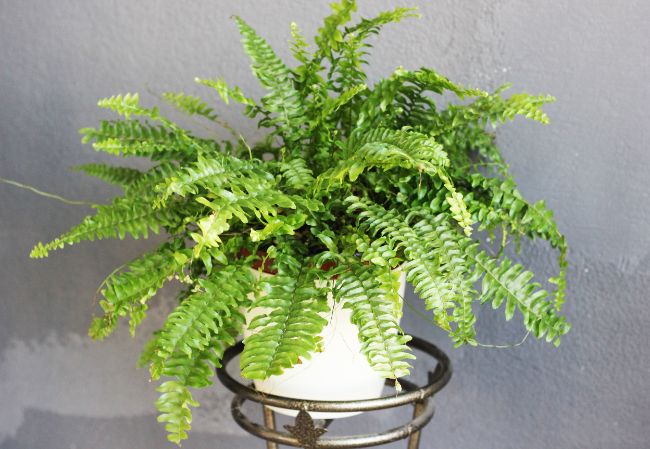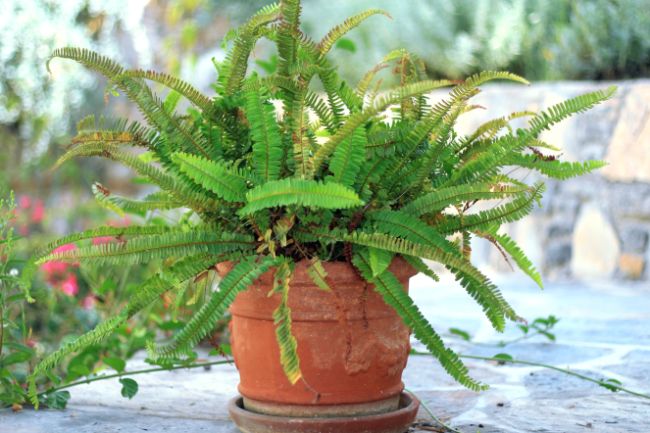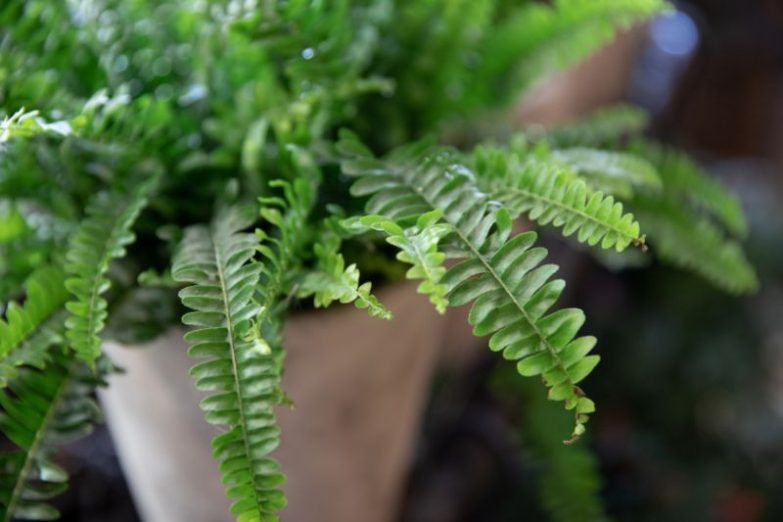With delicate compound leaves and long, lance-shaped fronds that cascade delicately down the sides of its container, the Boston Fern is a perfect choice to bring a touch of the tropics indoors. While not difficult to look after, it does need the right conditions to thrive. This article covers the most common reasons for a Boston Fern dying, and will help you get your struggling plant back to health.
The most common cause of a Boston Fern dying is overwatering or persistently waterlogged conditions. This results in root rot, that will quickly kill your plant. Low humidity, underwatering, overfertilizing, pests, or incorrect lighting can also lead to a decline or death of your plant over time.
This article is going to cover each problem in turn, and help you to adjust the growing conditions and make some changes to restore your plant to its former glory.
6 Reasons Why Your Boston Fern Is Dying
Although Boston Ferns (Nephrolepis exaltata) are pretty hardy, it’s not unusual for them to droop sadly, lose their lush foliage or turn brown.
If you think that your Boston Fern is knocking on death’s door, don’t panic. In most cases, it is completely possible to revive this plant with a little care and damage control.
Overwatering Is The Most Common Cause Of A Boston Fern Dying
All kinds of ferns like to sit in well-hydrated soil. However, they like a happy medium, where the soil remains moist but never stays soggy. Overwatering is one of the most common causes of a Boston Fern dying.
An overwatered Boston Fern will show its displeasure through yellowing and wilting leaves. Waterlogged soil causes the plant to develop root rot or other diseases. Once root rot sets in, it can be difficult to save the plant, so prevention is the aim of the game.
Look for the following symptoms of overwatering;
- Your Boston Fern is drooping, despite the soil being wet.
- The fronds are turning yellow, particularly the lower fronds first.
- The tips of the fronds are turning brown, despite plenty of water and humidity.
- It takes a long time for the soil to dry out after watering.
- You may detect an offensive smell from the soil. This is often an indicator of root rot.
So you think your Boston Fern has been overwatered and might have root rot, but how did this happen? Even if you’re careful with watering, there are a number of other factors to consider.
Your Boston Fern is more likely to develop root rot in the following conditions;
- Your Boston Fern is in a pot that is too large. The soil will take an excessively long time to dry out after watering, leading to prolonged, soggy conditions.
- Your pot has no or few drainage holes, so excess water cannot drain after watering.
- You forget to empty the drip tray or outer pot after watering, leaving the roots sitting in water.
- Your plant is in low light. Your Boston Fern will grow much more slowly and use less water in low light, leading to prolonged soggy soil after watering.
- You forget to reduce watering in winter. Boston Ferns usually stop growing in winter, so you must respond by reducing how much and how often you water them.
How To Fix A Boston Fern Dying From Overwatering
If you think your plant has been overwatered and is showing some of the above symptoms, you should follow these steps to fix your dying Boston Fern.
- Gently slide your Boston Fern out of the pot and remove excess soil to inspect the roots.
- Rotten roots will be black/brown, fragile, mushy, and will likely have an offensive smell. You should prune off all affected roots with sterile pruning shears. If you have to prune many roots, you should also prune the foliage back so that the remaining roots can support the plant.
- Gently rinse the healthy roots to remove as much of the old soil as possible. The old soil will still contain the pathogens that caused root rot, so it is best to plant in fresh soil.
- Choose a new pot that is just a little larger than the plant. Make sure it has plenty of drainage holes.
- Repot your Boston Fern using a well-draining houseplant potting mix, ideally with additional perlite or coarse sand to improve drainage.
- Only water your Boston Fern once the top 1-2 inches of soil feels dry, rather than watering on a schedule.
- Read my guide to fixing overwatered plants for more information.

Humidity Problems
Boston Ferns call tropical rainforests home, so naturally, they love an environment with lots of humidity. If the air inside your home is too dry, it might cause its foliage to curl up and turn brown. Also, your Boston Fern absolutely hates to be placed in front of, or near sources of warm drafts such as radiators, fires, or heating vents.
Humidity levels of at least 50% are required to keep your Boston Fern looking its best. Bear in mind that humidity levels tend to decrease in winter, as indoor heating systems tend to dry the air.
I use a digital hygrometer (humidity meter) to monitor humidity levels for my houseplants. This lets me know when I need to take a little action to boost humidity levels. Here is a link to the digital hygrometer I use.
How To Improve Humidity For Your Boston Fern
- Group your plants together. The collective transpiration from the foliage increases local humidity.
- Use a humidity tray. Place some pebbles in a large, shallow dish, before setting your plant on the pebbles. Fill the tray with a shallow layer of water, taking care that the water levels remain below the top of the pebbles. We don’t want the plant pot sitting in water, as this can encourage root rot.
- Use a humidifier to quickly and effectively improve humidity levels.
- Avoid misting your houseplants, as this tends to be surprisingly ineffective at raising humidity levels, and increases the risk of fungal and bacterial disease.
- Read my guide to improving humidity for houseplants here.
High humidity seldom poses a problem for Boston Ferns. However, lots of humidity and low ventilation can cause the plant to attract disease.
Lighting Issues
If your Boston Fern is shedding leaves by the dozen and is not the same bouncy plant that you brought home, it might be a signal that it is not getting the light that it needs to produce lush green fronds.
This plant is fond of lots of bright, indirect light – just as it receives on the rainforest floor through the canopy of trees. This is why it is advisable to place it near a window that gets ample indirect sunshine. It will be ecstatic if you place it in an area that gets a bit of morning sun and then lots of diffused sunlight in the later part of the day.
Remember that while a Boston Fern is unlikely to actually die when kept in a shaded location, it will not grow and flourish. Low light also increases the risk of overwatering, and a plant weakened by insufficient light can also be more susceptible to pests and diseases
At the other end of the lighting spectrum, the Boston Fern also dislikes being exposed to too much direct sun. Prolonged exposure to direct sunlight will scorch its tender foliage and cause the frond tips to turn brown.
Underwatering
Whilst a less difficult problem to identify and treat, underwatering can also result in a Boston Fern dying. Boston Ferns require soil that never dries out fully. If they are left without water for even a short period of time, the fronds will start to turn progressively brown, and your Boston Fern will start to look pretty sad.
Underwatering is a very easy mistake to make. We all lead busy lives, and it isn’t always easy to remember to water your plants. Here are some good ways to avoid underwatering.
- Put your plant somewhere you will see it on a regular basis, rather than tucked away in a corner. You’re much more likely to spot the first signs of trouble.
- Develop a regular habit for checking your houseplants. Tie this into your normal daily routine, so its almost automatic for you to give your plants a quick check.
- If you are forgetful or are going to be away for a while, consider using a self-watering pot or one of these methods to ensure your plant doesn’t dry out.

Pest Infestation
Just like most houseplants, Boston Ferns are susceptible to pest infestations. These pests can seriously damage the plant and can even result in your Boston Fern dying if left untreated.
Pests can often be identified if you inspect your plant closely on a regular basis, but some, such as spider mites, are so tiny that they are easily overlooked.
Many pests will damage your Boston Fern, resulting in yellow/brown leaves, generalized wilting, and a plant that is failing to thrive.
The best way to ensure that pests don’t cause your Boston Fern too much trouble is by inspecting your plant on a regular basis. Check the leaves, making sure to look at both sides, along with the stems and soil, for any evidence of pests.
Spider mites can be one of the most devastating pests to deal with. Look for fine wispy webs between the fronds, and if you look really closely, you should be able to see a swarm of spider mites.
Mealybugs are another example of common pests that pose a serious threat to your Boston Fern. These tiny, white cotton-like insects are visible to the naked eye and usually attack the underside of the leaves and roots of the plant. If not tackled in time, both mealybugs and spider mites can result in your Boston Fern dying.
Boston Ferns are also commonly troubled by fungus gnats and scale insects – both of which are difficult to spot. Fungus gnat larvae are present in the soil where they feed on the plant’s roots, thereby damaging them.
Scale insects, on the other hand, prefer living on the stem and leaves of the Boston Fern. Severe scale insect infestation might lead to stunted growth or even death of the plant.
What To Do If Your Boston Fern Is Dying Due To Pests?
The first and most important step is to quarantine your plant from any other houseplants to prevent the pests from spreading.
I normally physically remove as many pests as I can, either individually in the case of mealybugs or scale, or by using a showerhead or hose to gently wash as many of the pests off the plant as possible.
Once most or all of the pests have been removed, I like to treat my houseplants with either horticultural oil spray or neem oil solution, both of which are safe and fairly effective. I normally treat at weekly intervals until I haven’t spotted any pests for at least a fortnight.
Only once you’re absolutely sure all of the pests have been dealt with should you bring your Boston Fern back into contact with your other plants.
Read my guide to identifying, treating, and preventing common houseplant pests to learn more.
Is Your Boston Fern Dying Due To Overfertilizing?
Let’s admit it – overfertilizing houseplants is a really easy mistake to make. It’s so tempting to fertilize a little bit too often or enthusiastically in an effort to make our plants grow quicker and become even more impressive. And in our enthusiasm, we sometimes overfeed the plant.
Overfertilizing can cause direct toxicity to the foliage, resulting in brown fronds, particularly at the tips and edges. With more severe overfertilizing, root toxicity develops, which can damage or even kill the roots.
This prevents the plant from absorbing essential water and nutrients, so the whole plant can start to wilt, develop yellowing lower fronds, have stunted growth, or even result in your Boston Fern dying completely.
You may also see white/yellowish salt deposition on the soil surface, which can be a sign of excess fertilizer.
How To Fix A Boston Fern That Is Dying From Overfertilizing
If you think you’ve been fertilizing your Boston Fern too much, and it’s starting to struggle there are two options.
Option 1 – Flush the soil by running copious amounts of water through it for several minutes. This helps to wash excess fertilizer salts out of the soil. After this, avoid fertilizing for 6 months, and then resume a more conservative regime.
Option 2 – Repot your plant into fresh potting soil. This will cause more immediate stress for an aready struggling plant, but is often the right move for a severely impacted plant, as a last resort to save a dying Boston Fern.
Boston Ferns aren’t heavy feeders, so a dilute, balanced fertilizer applied every 2-3 months is plenty to keep a Boston Fern thriving. Here is a link to the fertilizer I use for my Boston Fern. There is no need to fertilize a Boston Fern during the winter months when growth will be very slow.
Last Word
If it looks like your Boston Fern is dying, it’s likely one of the problems discussed in this article. Thankfully, most problems can be correctly identified by taking a close look at the plant and the conditions that it is growing in.
Root rot and pests require immediate attention to save your plant, while some of the other issues simply need a slight adjustment in the care conditions.
Looking after houseplants is a constant learning process, and sometimes plants struggle despite out best efforts. And when you encounter another of your houseplants struggling, just remember that an expert in any field has failed more times than the novice has even tried!

